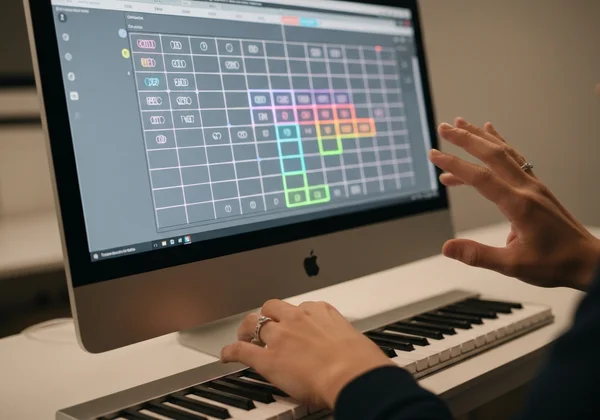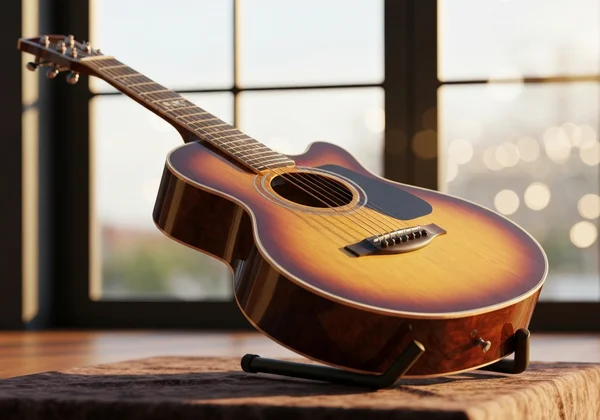가상 기타로 팝 음악의 코드 진행 연주하기: 온라인 시뮬레이터 가이드
차트 1위 팝송을 듣고 전에 들어본 것 같다는 느낌을 받은 적이 있나요? 맞습니다. 전 세계에서 가장 귀에 맴도는 많은 곡들이 강력하고 검증된 몇 가지 음악적 공식으로 만들어졌습니다. 일반적인 코드 진행 으로 알려진 이 공식들은 수많은 히트곡의 숨겨진 비결입니다. 하지만 값비싼 장비를 사거나 레슨을 등록하지 않고 어떻게 이 비결들을 마스터할 수 있을까요? 좋은 소식은, 그것들을 마스터하는 비결은 생각보다 간단하다는 것입니다. 바로 가상 기타 만 있으면 손쉽게 할 수 있습니다.
이 가이드는 팝 음악 뒤에 숨겨진 매력을 알려드릴 것입니다. 현대 음악의 근간을 이루는 네 가지 가장 필수적인 코드 진행을 살펴볼 것입니다. 더 중요한 것은, 저희의 무료 온라인 기타 도구를 활용하여 즉시 연주하고, 연습하고, 창작하는 방법을 보여드릴 것입니다. 지금 바로 저희의 무료 온라인 기타 로 음악을 이해하는 방식을 바꾸고 작곡 여정을 시작할 준비를 하세요.

일반적인 코드 진행 이해: 팝 음악의 핵심
패턴에 뛰어들기 전에, 그것들이 왜 효과적인지 이해하는 것이 중요합니다. 코드 진행은 단순히 특정 순서로 연주되는 일련의 코드입니다. 감정을 만들고, 이야기를 들려주며, 듣는 이의 귀를 사로잡는 음악적 문장이라고 생각해보세요. 팝 음악에서 이러한 진행은 예측 가능하고 만족감을 주도록 구성되어, 새로우면서도 친숙하게 느껴지는 감정적 연결을 만듭니다.
이 기반은 눈물을 흘리게 하는 진심 어린 발라드부터 흥을 돋우는 경쾌한 찬가에 이르기까지 모든 것을 지탱합니다. 이러한 패턴을 배우는 것은 수동적인 청취자에서 능동적인 창작자로 전환하는 첫 번째 중요한 단계입니다. 음악을 단순히 듣는 것을 넘어 그 언어를 이해하기 시작하는 순간입니다.
코드 진행이 팝적인 이유와 그 중요성
그렇다면 특정 진행이 팝적인 이유는 무엇일까요? 그것은 모두 긴장과 해소에 관한 것입니다. 우리의 뇌는 패턴을 인식하도록 설계되었으며, 음악도 예외는 아닙니다. 귀에 맴도는 코드 진행 은 궁극적으로 기분 좋게 해소되는 음악적 긴장감을 만듭니다. 긴장감에서 만족으로 이어지는 이 여정이 노래를 기억에 남게 하고 다시 재생 버튼을 누르고 싶게 만듭니다.
이러한 진행을 마스터한다고 해서 음악이 획일적으로 들리게 되는 것은 아닙니다. 오히려 검증된 프레임워크를 제공합니다. 이 기반 위에 독특한 멜로디, 리듬, 가사를 구축할 수 있습니다. 이러한 핵심 구조를 이해하면 혁신할 자유를 얻게 되며, 노래의 음악적 토대가 견고하고 효과적이라는 것을 알게 됩니다.
저희 플랫폼이 기타 작곡 기초를 배우는 데 이상적인 도구인 이유
음악가를 꿈꾸는 사람들에게 가장 큰 장애물은 종종 접근성입니다. 실제 기타는 돈이 들고, 레슨은 시간이 걸리며, 복잡한 소프트웨어는 부담스러울 수 있습니다. 저희 가상 기타 플랫폼 은 이 모든 장벽을 해소해 줍니다. 브라우저에서 직접 실행되며 다운로드나 비용이 전혀 들지 않는 강력한 온라인 기타 시뮬레이터입니다. 기타 작곡의 기초 를 배우기에 완벽한 환경입니다.
저희 플랫폼을 사용하면 코드 진행을 읽자마자 바로 들어볼 수 있습니다. 직관적인 인터페이스를 통해 간단한 마우스 클릭으로 코드를 연주할 수 있으며, 더 나아가 컴퓨터 키보드를 활용할 수도 있습니다. 이러한 즉각적인 실습 피드백은 음악적 개념을 내면화하는 데 매우 중요합니다. 아무런 부담 없이 실험하고, 실수하고, 새로운 아이디어를 발견할 수 있어 이상적인 연습 도구 가 됩니다.

빅 4: 지금 바로 연주해야 할 필수 팝 코드 진행
이제 신나는 부분을 살펴볼까요? 가장 상징적인 네 가지 팝 음악의 코드 진행을 살펴보겠습니다. 로마 숫자를 사용할 것입니다. 이는 'I'가 키의 첫 번째 코드, 'IV'가 네 번째, 'V'가 다섯 번째, 'vi'가 여섯 번째(단조 형식)를 나타내는 간단한 시스템입니다. 예시로는 연주하기 쉬운 C 장조를 사용하겠습니다.
C 장조의 코드는 다음과 같습니다.
- I = C 장조
- IV = F 장조
- V = G 장조
- vi = A 단조 (Am)
준비되셨나요? 가상 기타 도구 를 실행하고 연주해봅시다.
진행 1: '기분 좋은 느낌의' I-V-vi-IV (장조 코드 진행)
C 장조의 코드: C - G - Am - F
이 진행은 현대 음악에서 가장 유명한 진행 중 하나입니다. 2000년대 팝송부터 오늘날의 가장 큰 히트곡에 이르기까지 이 순서는 어디에나 있습니다. 낙관적이고, 고양되며, 약간 향수를 불러일으키는 느낌으로 즉시 알아볼 수 있습니다. 그 힘은 강하게 시작하고, 기대를 쌓고, 단조 코드로 약간의 애잔함을 더하고, 아름답게 해결하는 완벽한 균형에 있습니다. 이것이 장조 코드 진행 의 초석입니다.
진행 2: 클래식 발라드 I-vi-IV-V (감정적 공명 탐구)
C 장조의 코드: C - Am - F - G
종종 50년대 진행이라고 불리는 이 순서는 고전적인 사랑 노래, 두왑, 진심 어린 발라드의 사운드입니다. 부드럽고, 온화하며, 깊이 로맨틱한 분위기를 만듭니다. 밝은 'I' 코드에서 부드러운 'vi' 코드로 부드럽게 전환함으로써, 스토리텔링과 감정적 공명 탐구 에 완벽한 톤을 설정합니다. 마음을 울리는 노래를 쓰고 싶을 때, 이 진행이 바로 당신의 선택입니다.
진행 3: 드라이빙 록 I-IV-V-I (고에너지 코드 시퀀스)
C 장조의 코드: C - F - G - C
단순하고, 강력하며, 직접적입니다. 이 진행은 로큰롤, 블루스, 그리고 수많은 에너지 넘치는 팝송의 기반입니다. 순수하고 변질되지 않은 음악적 에너지입니다. I에서 IV, V로의 진행은 I 코드로 돌아오면서 완벽하게 해소되는 강력한 긴장감을 형성합니다. 이러한 고에너지 코드 시퀀스 는 추진력 있고 전진하는 느낌을 만드는 데 완벽합니다. 저희 온라인 기타 에서 일렉트릭 기타 톤으로 전환하여 그 힘을 직접 느껴보세요.
진행 4: 단조 키의 마법 vi-IV-I-V (드라마와 깊이 더하기)
C 장조의 코드: Am - F - C - G
단조 'vi' 코드로 시작하는 것은 전체적인 분위기를 완전히 바꿉니다. 이 진행은 더 극적이고, 진지하며, 내성적인 느낌을 줍니다. 약간의 무게감이 필요한 웅장하고, 분위기 있고, 강력한 노래를 만드는 데 현대 작곡가들이 선호하는 진행입니다. 내성적인 느낌으로 시작하여 I 및 V 코드로 강력한 해결을 향해 나아감으로써 음악에 드라마와 깊이 를 더하는 것입니다. 이는 코드 자체만큼 코드의 순서가 중요하다는 것을 증명합니다.
기본을 넘어서: 가상 기타로 창의력 발휘하기
이제 팝 음악의 네 가지 핵심 진행을 배웠습니다. 하지만 이것은 시작에 불과합니다. 목표는 단순히 다른 사람들이 한 것을 복사하는 것이 아니라, 이 도구들을 사용하여 자신만의 독창적인 결과물을 만드는 것입니다. 여기서 실용적이고 직접적인 방식으로 진정으로 온라인 음악 이론을 배울 수 있습니다. 이 온라인 기타 시뮬레이터 는 연습뿐만 아니라 창의적인 탐구를 위해 설계되었습니다.
다음 단계는 이러한 빌딩 블록을 가지고 자신만의 음악적 아이디어를 구성하기 시작하는 것입니다. 실험하는 것을 두려워하지 마세요. 순서를 바꾸거나, 리듬을 변경하거나, 멜로디를 흥얼거려 보세요. 모든 작곡가는 정확히 이와 같은 코드로 시작했습니다.
악기별 톤 탐색: 어쿠스틱, 클래식, 일렉트릭 기타 사운드
저희 플랫폼의 가장 강력한 기능 중 하나는 악기를 즉시 변경할 수 있다는 것입니다. 동일한 코드 진행도 다른 기타로 연주하면 완전히 다르게 느껴질 수 있습니다. 따뜻하고 친밀한 느낌을 위해 풍부한 어쿠스틱 기타 사운드 를 사용하여 클래식 발라드 진행을 연주해 보세요.
이제 기타 톤을 일렉트릭 기타 톤으로 전환하고 드라이빙 록 진행을 연주해 보세요. 에너지와 태도의 변화를 즉시 느낄 수 있을 것입니다. 클래식 기타 톤은 더 섬세하거나 복잡한 아이디어에 완벽한 또 다른 음색의 폭을 제공합니다. 이 기능을 사용하면 세 가지 다른 악기가 필요 없이 노래에 대한 다양한 음향 질감을 시험해 볼 수 있어, 음악적 아이디어에 완벽한 목소리를 찾는 데 도움이 됩니다.

오리지널 곡을 향한 첫걸음: 배운 것을 적용하기
이제 필요한 강력한 작곡 공식 을 마음대로 사용할 수 있습니다. 그것들을 화가의 기본 색상이라고 생각해보세요. 혼합하고 조합하여 무한한 수의 새로운 색조를 만들 수 있습니다. I-V-vi-IV 진행을 연주하되, 해결하는 대신 vi-IV-I-V 진행으로 바로 넘어가 보세요. 어떤 느낌인지 들어보세요.
가상 기타를 음악적 스케치북으로 사용하세요. 간단한 멜로디를 흥얼거리고 어떤 진행이 그 멜로디와 어울리는지 찾아보세요. 연주하면서 휴대폰에 음성 메모를 녹음하세요. 첫 곡을 쓰는 여정은 배운 것을 적용하는 이 간단한 실천에서 시작됩니다. 완벽함에 대해 걱정하지 마세요. 창작의 즐거움에 집중하세요.
가상 기타로 팝 작곡 성공을 위한 다음 단계
오늘 엄청난 발걸음을 내디뎠습니다. 당신이 사랑하는 음악의 기반이 되는 기본적인 코드 진행을 배웠고, 연습과 창작을 그 어느 때보다 쉽게 만들어주는 도구를 발견했습니다. 이제 모든 훌륭한 팝송 뒤에는 당신이 마스터할 수 있는 단순하고 우아한 구조가 있다는 것을 알게 되었습니다.
핵심은 계속 연주하는 것입니다. 이 네 가지 진행이 제2의 천성처럼 느껴질 때까지 익숙해질 때까지 반복하세요. 다양한 키, 리듬, 톤으로 실험해 보세요. 가장 중요한 것은 이러한 견고한 토대 위에 자신만의 독특한 멜로디를 구축하기 시작하는 것입니다.
첫 히트곡을 쓸 준비가 되셨나요? 지금이 가장 좋은 때입니다. 저희 무료 가상 기타 를 열고, 좋아하는 사운드를 선택하고, 음악적 아이디어를 현실로 만들어 보세요.
팝 코드 진행 및 가상 기타에 대한 자주 묻는 질문
키보드로 온라인 기타를 연주하는 방법은 무엇인가요?
저희 가상 기타는 사용하기 쉽게 설계되었습니다. 마우스로 현을 클릭할 수도 있지만, 더 원활한 경험을 위해 기타 현을 컴퓨터 키보드에 매핑했습니다. 키보드의 상단 열(Q, W, E, R...)은 높은 현의 프렛에 해당하고, 하단 열(A, S, D, F...)은 낮은 현의 프렛을 연주합니다. 이 직관적인 레이아웃을 통해 코드와 멜로디를 효율적으로 연주할 수 있습니다.
온라인으로 기타를 무료로 배울 수 있나요?
물론입니다. 저희 무료 가상 기타 플랫폼 은 음악 접근성을 높이는 데 전념하고 있습니다. 비용, 구독료, 숨겨진 수수료 없이 코드를 배우고, 스케일을 연습하며, 작곡을 실험할 수 있습니다. 저희의 목표는 기타 연주를 배우고 싶은 모든 사람에게 고품질 도구를 제공하는 것입니다.
코드를 배우기에 가장 좋은 가상 기타 웹사이트는 어디인가요?
많은 옵션이 있지만, 저희 온라인 기타 시뮬레이터는 여러 면에서 뛰어납니다. 여러 고품질 기타 톤(어쿠스틱, 클래식, 일렉트릭), 직관적인 키보드 연주 모드, 깨끗하고 광고 없는 인터페이스를 제공합니다. 저희 가상 기타는 학습 도구이자 창의적인 스케치북으로 설계되었기 때문에, 코드를 빠르게 배우고 적용하려는 초보자와 작곡가에게 이상적인 플랫폼입니다.
이러한 일반적인 코드 진행은 모든 음악 장르에서 사용되나요?
팝, 록, 컨트리 음악에서 가장 지배적이지만, 이러한 진행의 변형은 R&B, 포크, 심지어 일부 형태의 재즈 및 클래식 음악을 포함하여 거의 모든 서양 음악 장르에서 나타납니다. 그들의 보편적인 매력은 그것들이 내포하는 음악적 긴장과 해소의 근본적인 원리에서 비롯됩니다.
이 플랫폼이 기타 작곡의 기초에 어떻게 도움이 될 수 있나요?
저희 플랫폼은 작곡 학습에 가장 중요한 요소인 즉각적인 오디오 피드백을 제공합니다. 코드 진행에 대해 단순히 읽는 대신, 즉시 들을 수 있습니다. 다양한 코드가 함께 어떻게 들리는지 테스트하고, 순서를 바꾸는 실험을 하며, 전환이 부드러워질 때까지 연습할 수 있습니다. 이는 자신감과 음악적 감각을 키울 수 있는 위험 부담 없는 환경입니다.